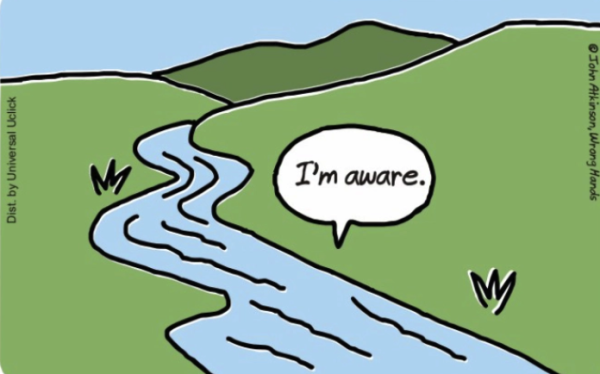Perfect Tens: Kid A
“Creep” is a bad song. At least that is what the members of Radiohead want people to
think about their most popular single. The members thought “Creep” was too simple and so
they set to separate themselves from the hit. As they produced the next two albums, they
innovated their rock sound. Their third album, OK Computer, proved to be a massive critical and
commercial success, even winning the Grammy award for Album of the Year in 1998. With the
success of this album, Radiohead went on a full world tour. During this tour, lead singer Thom
Yorke suffered a mental breakdown. The frontman said that before, whenever he wrote music,
it helped him deal with anxiety, but now music had become the leading cause of his anxiety.
The rest of the band felt that they had to create something completely different to keep
themselves from being a one-trick band. This new direction, which focused on sounds and
textures rather than traditional melodies, aided Yorke with his writer’s block. In October of
2000, Radiohead released their fourth album, Kid A.
The album surprised many listeners upon release. They did not understand the direction
that Radiohead had gone in. Pitchfork magazine gave the album a four out of ten, but just days
later, they re-released the review with a new score: ten out of ten. Slowly, critics proceeded to
pick up on the genius of the album and more perfect reviews came flowing in. The album hit
number one on both the US and UK Billboard charts, without a radio hit or a music video. This
success created the age of Internet music streaming. People could listen to the album, read the
reviews, and share their opinions all on their computers. Years later, the album still receives
praise, with Rolling Stone ranking Kid A as the Best Album of the 2000s and Time Magazine
including the record in their All-Time 100 Albums list. It has become and undisputed fact that
this fourth album, made from the likenesses of singer Thom Yorke, guitarist Ed O’Brien,
drummer Phil Selway, and brothers Jonny and Colin Greenwood, who play guitar and bass
respectively, is a bona fide masterpiece due to the way it surpasses expectation, defies genre,
and relays raw emotion through the use of electronic music and effects intertwined with the
instrumentation that Radiohead is known for.
At the time, Radiohead shocked many seasoned fans with their opening track,
“Everything In Its Right Place,” due to the lack of any guitars. Instead, Yorke’s electric piano
chords captain the song, while a bass line echoes the melody. Yorke puts together a remarkable
vocal performance along with remixed loops of his vocals that create an eerie atmosphere for
the track. This song not only tops any other opener from a Radiohead album, but is also one of
the best of their extensive catalog. The electronic piano continues with the titular track, “Kid
A.” This time the piano plays singular notes reminiscent of a lullaby, however, with their various
textures, the band make this a warped lullaby. As the song progresses, the bass and drummer
Selway’s impressive beat impose upon the soft piano and give the track a groove.
“The National Anthem” has the most prominent bass line from any song on the album
as Colin Greenwood’s driving instrument continues throughout the entire track. His brother,
Jonny, plays on an uncommon instrument called Ondes Martenot, which adds unnerving
wavering notes. As the song progresses, brass instruments start to fill in. The instruments seem
to play at free will, symbolizing the insanity that Yorke felt on tour with OK Computer. As more
layers of brass come in, the deeper the track decends into the madness, with the only thing
keeping the listener sane being the nonstop bass. Another phenomenal track, “How To
Disappear Completely,” follows and it sees the Greenwood brothers play the same instruments
from the previous song, while Yorke strums on his acoustic guitar. The exclusively minor chords
provide the song with a depressing tone that the lyrics add to. During the chorus, Yorke sings,
“I’m not here. This isn’t happening.” These lyrics were advice given to Yorke from Michael Stipe
of R.E.M. to repeat to himself when he had an anxiety attack. In the final minutes, a string
arrangement perfects the unnerving atmosphere. The final song on the first half, “Treefingers,”
is an instrumental track that settles the listener back down from the previous two tracks. The
digital recordings of guitarist O’Brien’s instrument give the album hope for more optimism on
the second half.
This is exactly what they get with “Optimistic,” the most appropriately titled song on the
album. The upbeat guitar progression lifts the listener from the heavy first half. Yorke repeats
“You can try the best you can. The best you can is good enough,” something that his partner
would tell him at the time of recording the album. Yorke felt that nothing they had recorded at
that point was worth releasing and these words helped him think otherwise. The end of the
song turns to a bass line which flows onto “In Limbo.” This track’s descending notes impress
and combine well with the beat from the drums and bass. Yorke says “You’re living in a fantasy”
which fits, considering the title. A modular synth combined with Selway’s drums provide the
beat for “Idioteque,” Radiohead’s interpretation of dance music. This song takes the idea of
remixing Yorke’s voice from “Everything In Its Right Place,” and adds these loops to the beat.
Yorke rapidly sings during the second verse and repeats with increasing intensity, “take the
money and run,” which adds to the ominous tone of the song. This track contends for one of
the best songs Radiohead has ever produced. The synth beat continues onto “Morning Bell.”
The recurring electronic piano and guitars combine in this track, while Selway provides another
groovy beat on the drums. Yorke shows off his songwriting skills by taking an everyday saying,
“Where’d you park the car?” and makes the lyric unnerving.
The final song on the album, “Motion Picture Soundtrack,” attempts to recreate
soundtracks from animated films in the 50s. Yorke plays solo on a pedal organ in the first verse
before being joined by a harp and choir in the second. The song attempts combine old and new
sounds, which perfectly shows the complexity of Radiohead. Yorke overcame his severe anxiety
with Kid A’s release and the band has since continued to produce five more records, all with the
same complexity they achieved with this album. Kid A proved Radiohead to be more than a
good band. Kid A allowed Radiohead transform from an already impressive rock band to
certified musical masterminds. Kid A solidified Radiohead as the generation’s most influential
band, as one that is still making waves in rock bands today.


